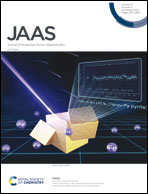A hybrid wavelength selection strategy-based quantitative analysis model for LIBS data from standard ground samples of the Curiosity rover on Mars†
Abstract
Laser-induced breakdown spectroscopy (LIBS) is a useful tool for the in situ detection of material components on Mars. This technique can directly acquire key information, such as the types and abundance of elements in the surface rocks and soil of Mars, with submillimeter spatial precision. Because the LIBS signal is prone to interference from the sample matrix and self-absorption effects, as well as other factors, the accuracy of its qualitative and quantitative analyses can be diminished without proper treatment. High-resolution LIBS generates hundreds or thousands of variables, causing low efficiency or high probability of overfitting in wavelength selection algorithms. Chemometric methods can be used to overcome the effects of these factors, extract useful information from the complex spectral data, and establish more robust analytical models. In this paper, model population analysis (MPA) combined with a range of variable selection methods is used to analyze the standard ground samples of the ChemCam team quantitatively. The analytical performance of LIBS is improved by optimizing and improving the algorithms. The results show that the two-step hybrid modeling method based on MPA has excellent prediction performance. Compared with other single or hybrid models, our method enables extensive use of the strengths of the models used and compensates for their weaknesses when handling high-dimensional datasets. The model established in this paper may contribute to the quantitative analysis of LIBS spectral data in future Mars exploration missions.

- This article is part of the themed collection: JAAS HOT Articles 2022


 Please wait while we load your content...
Please wait while we load your content...